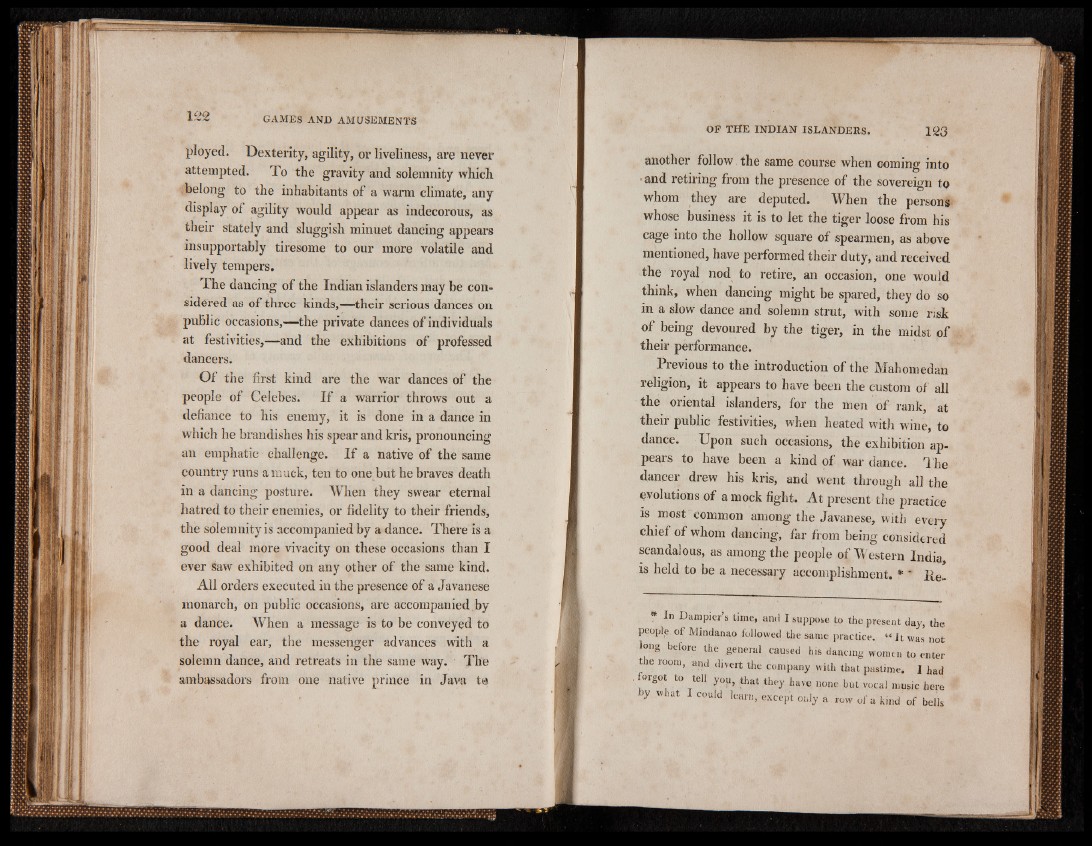
ployed. Dexterity, agility, or liveliness, are never
attempted. To the gravity and solemnity which
belong to the inhabitants of a warm climate, any
display of agility would appear as indecorous, as
their stately and sluggish minuet dancing appears
insupportably tiresome to our more volatile and
lively tempers.
The dancing of the Indian islanders may be considered
as of three kinds,—their serious dances on
public occasions,—the private dances of individuals
at festivities,—and the exhibitions of professed
dancers.
Of the first kind are the war dances of the
people of Celebes. If a warrior throws out a
defiance to his enemy, it is done in a dance in
which he brandishes his spear and kris, pronouncing
an emphatic challenge. I f a native of the same
country runs a muck, ten to one but he braves death
in a dancing posture. When they swear eternal
hatred to their enemies, or fidelity to their friends,
the solemnity is accompanied by a dance. There is a
good deal more vivacity on these occasions than I
ever Saw exhibited on any other of the same kind.
All orders executed in the presence of a Javanese
monarch, on public occasions, are accompanied .by
a dance. When a message is to be conveyed to
the royal ear, the messenger advances with a
solemn dance, and retreats in the same way. The
ambassadors from one native prince in Java to
another follow the same course when coming into
* and retiring from the presence of the sovereign to
whom they are deputed. When the persons
whose business it is to let the tiger loose from his
cage into the hollow square of spearmen, as above
mentioned, have performed their duty, and received
the royal nod to retire, an occasion, one would
think, when dancing might be spared, they do so
in a slow dance and solemn strut, with some risk
of being devoured by the tiger, in the midst of
their performance.
Previous to the introduction of the Mahomedan
religion, it appears to have been the custom of all
the oriental islanders, for the men of rank, at
their public festivities, when heated witJi wine, to
dance. Upon such occasions, the exhibition appears
to have been a kind of war dance. The
dancer drew his kris, and went through all the
evolutions of a mock fight. At present the practice
is most common among the Javanese, with every
chief of whom dancing, far from being considered
scandalous, as among the people of W estern India
is held to be a necessary accomplishment. * ‘ p e.
In Dampier s time, and I suppose to the present day, the
people of Mindanao followed the same practice. “ It was not
lon& before the general caused his dancing women to enter
the room, and divert the company with that pastime. I had
forgot to tell you, that they have none but vocal music here
y vi at could learn, except only a row of a kind of bells